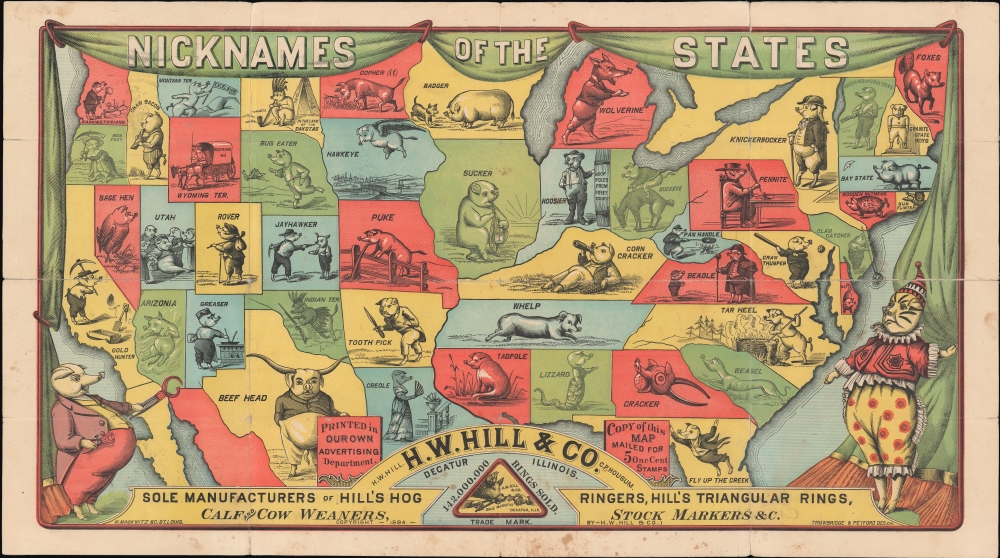This item has been sold, but you can get on the Waitlist to be notified if another example becomes available, or purchase a digital scan.
1884 Hill 'Nicknames of the States' Map of the United States w/Pigs
UnitedStatesofPigs-mackwitz-1884
Title
1884 (dated) 13 x 23.5 in (33.02 x 59.69 cm)
Description
Chromolithography
Chromolithography is a color lithographic technique developed in the mid-19th century. The process involved using multiple lithographic stones, one for each color, to yield a rich composite effect. Oftentimes, the process would start with a black basecoat upon which subsequent colors were layered. Some chromolithographs used 30 or more separate lithographic stones to achieve the desired product. Chromolithograph color could also be effectively blended for even more dramatic results. The process became extremely popular in the late 19th and early 20th centuries, when it emerged as the dominate method of color printing. The vivid color chromolithography produced made it exceptionally effective for advertising and propaganda imagery.Publication History and Census
This map was designed by Chicago artists William Eugene Sutphin Trowbridge and Charles Edgar Petford, working as 'Trowbridge and Petford' and printed in St. Louis by William Mackwitz. Rare. We note examples at the Library of Congress, in the P. J. Mode Collection of Persuasive Cartography at Cornell, the University of Minnesota-Minneapolis, and the Newberry Library in Chicago.CartographerS
William Eugene Sutphin Trowbridge (October 13, 1832 - c. 1920) was a Chicago-based artist and illustrator active in the second half of the 19th century. Trowbridge was born in Danbury, Connecticut but was active in Rockville, Illinois, then Chicago from 1872. He appears through this period in various Chicago directories as an artist, sign painter, real estate agent, clerk, and secretary. In the 1880s he was a partner with Charles E. Petford (1854 - 1920) in the graphic design firm 'Trowbridge and Petford'. More by this mapmaker...
Charles Edgar Petford (1854 - February 9, 1920), a.k.a. C. Edward Petford, was a Chicago-based artist, architect, and graphic designer active in the second half of the 19th century. Petford was born in London and lived his early years in Birmingham, England. He worked in England as a theater set and costume designer. Afterwards, he traveled extensively to India, South America, and England before emigrating to the United States and settling in Chicago in 1881. There he was a staff artist for the Chicago Tribune. In the 1880s he was a partner with William E. S. Trowbridge (1832 - 1920) in the graphic design firm 'Trowbridge and Petford'. Petford was arrested for polygamy in Malden, Massachusetts in 1907, where he apparently kept a second wife, in addition to his Chicago wife. Around 1915, in retirement, he moved to Norwich, Connecticut. There, he worked as a designer for the Davis Theater before he died of pneumonia. Learn More...
William Mackwitz (February 21, 1831 - August 6, 1919) was a German-American engraver and lithographer active in St. Louis in the second half of the 19th century. Mackwitz was born in Braunschweig, Germany and emigrated to the United States in 1856 - settling in St. Louis. He worked as an engraver in St. Louis for roughly 60 years. A collection of Mackwitz notebooks and sketchbooks survive at the Missouri History Museum. Learn More...

